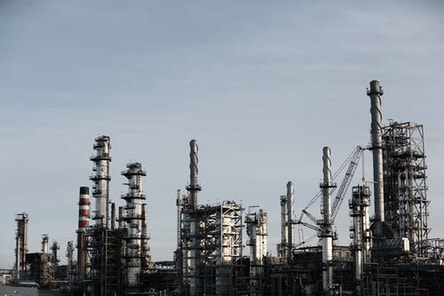|
Production volumes of oil refineries are huge as are their carbon footprints, so even a small reduction in their waste can have an outsize impact. Recycling anything and everything possible from the refining process, like raw materials, water, and energy can also result in real benefits. What one person calls "waste" can be someone else's raw material in a true circular economy.
The basic principle of oil refining involves heating crude oil to separate different fractions through distillation. This separation process results in gasoline, aviation fuel, and diesel, as well as heavier fractions, such as heating oil, bunker fuel, and bitumen. Crude oil fractions can also be turned into base oil, which is used to manufacture lubricating oils. When the different fractions have been separated the challenging part of the process begins, and that’s where attention to waste reduction is critical. |
Gas and Metals
The refining process also generates a variety of gases. Hydrocarbon gases can be used in the refinery's own energy production, and some of the gases are recovered and sold as feedstock to the petrochemical industry. CO2 that’s partly recovered in the hydrogen production unit can be purified further and used as a propellant, in the food industry, or as an extinguishing media.
Unwanted substances like sulfur can be recovered and provided as raw material to the chemical industry. Precious metals like vanadium can be separated and given a second life. Vanadium-steel alloys are used in gears, axles and crankshafts, and vanadium-gallium tape is used in superconducting magnets. Catalysts, usually tiny aluminum oxide granules with a small amount of precious metals on their surface, are used to speed up the refining process. When they need to be replaced, the metals, like platinum, can be recovered from the spent catalyst.
The refining process also generates a variety of gases. Hydrocarbon gases can be used in the refinery's own energy production, and some of the gases are recovered and sold as feedstock to the petrochemical industry. CO2 that’s partly recovered in the hydrogen production unit can be purified further and used as a propellant, in the food industry, or as an extinguishing media.
Unwanted substances like sulfur can be recovered and provided as raw material to the chemical industry. Precious metals like vanadium can be separated and given a second life. Vanadium-steel alloys are used in gears, axles and crankshafts, and vanadium-gallium tape is used in superconducting magnets. Catalysts, usually tiny aluminum oxide granules with a small amount of precious metals on their surface, are used to speed up the refining process. When they need to be replaced, the metals, like platinum, can be recovered from the spent catalyst.
|
Water and Energy
Resource efficiency principles can also be applied to energy, with extra heat generated by the refinery’s heat exchanger also being utilized. The average refinery requires 2.5 gallons of water for every gallon of crude oil processed. Depending on the type of crude oil, composition of condensate and treatment processes, the characteristics of refinery wastewater varies widely, but recycling the water can remove harmful pollutants. |
Refineries can reuse the heat they generate.
|
Recycling oil-bearing secondary materials can produce a solids cake that can be disposed of in landfills as non-hazardous waste. Refineries committed to the circular economy can generate hardly any waste comparable to their output, other than some salts and sand. This recycling process helps reduce environmental risk while recovering an estimated 31,000 barrels of oil per year, reducing the industry’s dangerous emissions.



